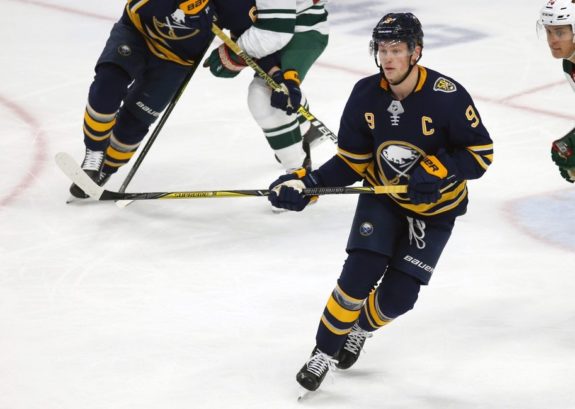For some months, reports led us to believe that the Buffalo Sabres could trade Jack Eichel at any moment. More recently, there have been stretches when it seems like the deal was far from happening. His health and viability for this coming season has often come up as a deterrent for prospective suitors. The situation with his needed surgery has also brought on discussions in some circles that changes need to be made between the NHL and the player’s association around who gets the final say on medical procedures. The two sides have stepped into the fray of the issue. For Sabres fans, it’s been a roller coaster of emotion.
General manager Kevyn Adams is standing his ground on a fair return for a player that the franchise gave up a lot to acquire. Let’s not forget that Eichel is a Sabre due to a painful “tank season” that cost Ted Nolan his job and possibly a chance at ever coaching in the NHL again. More than that, it caused a fan base anguish as it watched the team become a laughing stock in the face of the rest of the league, on a level that only Toronto Maple Leafs fans can relate to in the last decade.

One question that hasn’t been discussed a whole lot heading into training camp this month is: what does an Eichel trade mean for the Sabres’ cap situation?
Eichel Trade Could Put Sabres Below Cap Floor
If we take into account each of the 23 players that are under contract and expected to make the Sabres roster for 2021-22 — including Eichel, plus the buyout charge of Cody Hodgson’s contract, which is set at $791,667 — the Sabres’ projected cap hit this season according to CapFriendly is around $58 million, give or take depending on who is in the opening-night lineup. That’s $2 million-plus away from the cap floor of $60.24 million.
Remember, though, that the Sabres have yet to sign defenseman Rasmus Dahlin whose contract value will certainly be worth more than $2 million per year. So, that means if they keep Eichel, they will be fine cap-wise, even if he is on injured reserve.
Before I get hammered in the comments, a side note here: long-term injured reserve or LTIR is an often misunderstood clause with the cap system. As The Athletic’s Sabres reporter John Vogl explained succinctly in a recent piece:
The lingering misconception about LTIR is that it serves a purpose for teams under the cap. It doesn’t. Cap savings from LTIR don’t kick in until a team goes over the cap.
For example, say a team spends to the cap limit of $81.5 million. If it had a $10 million player suffer a long-term injury, then it could use an LTIR designation to spend above $81.5 million.
Since the Sabres are nowhere near the upper limit, Eichel would just be on regular IR and count toward the cap.
‘Sabres mailbag: What happens if Jack Eichel isn’t traded? Can LTIR be used? Who can replace him?’ John Vogl, The Athletic, Sept. 10, 2021.
Last season’s Tampa Bay Lightning team is a famous example. The Lightning would have been over the cap had Nikita Kucherov not been placed on LTIR during the regular season. He came back for the playoffs when the cap is not a consideration for the roster according to current NHL rules.
The Sabres are not anywhere close to going over $81.5 million in contracts. That means that if Eichel is still on the team and injured to start the season, he will be placed on injured reserve, and his contract will still count against the cap. Where it gets interesting is if and when he is traded.
Sabres Would Need to Bring in Money if Eichel Is Traded
Like with any trade, it’s hard to say exactly what would have to happen to put together a deal that would please both the Sabres and a potential trade partner. The rumored asking price for Eichel is quite high but also heavy on prospects and/or draft picks. Whether or not Adams has been persuaded to lower this price is something that is often reported on.
Right now, it seems like the GM started the negotiations at a high point back at the beginning of the summer and has since been whittled down a bit. But with tight lips all around, it’s only speculation that fills the gaps. The true negotiation is being done behind closed doors. One thing is clear, however, once Eichel’s salary is off the books, the Sabres will need to bring in money just to reach the cap floor.
Some money could be coming back in the deal, especially if a No. 1 center is included. A trade partner might also entice the team to eat some of Eichel’s $10 million salary, which could also help ease the cap issues the trade will pose. However, this would be a rather unpopular move.
As summer wanes with the approaching training camp just around the corner and the regular season soon to follow, the plot thickens a bit for the Sabres when cap considerations are added into the mix. The result could be a draft pick or prospect-heavy deal with a free-agent signing soon to follow or, perhaps, enough money coming back in the other direction for Eichel to satisfy cap restrictions, with or without the team retaining some of his salary.
There are no shortages of storylines to follow with the Sabres, and the Eichel saga is just one of them. With cap concerns, his injury status and an ongoing dispute surrounding the neck surgery he needs, it’s beginning to look more and more like Captain Jack will be with the team to start the season. But that doesn’t mean an eleventh-hour deal is impossible. All we can do as followers at this point is sit back and watch.
